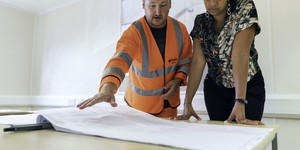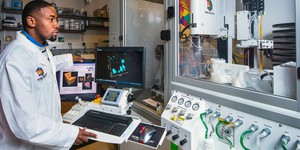Abstract
Here's a project for a budding architect or structural engineer. Can you make a strong, lightweight tower using only uncooked spaghetti and white glue? In this project, you'll learn about materials testing and apply what you learn to building and testing structures that are both strong and light.Summary
Elmer's® is a registered trademark of Elmer's Products, Inc.
Objective
The overall goal of this project is to test different methods for building structures that are both strong and light. You will use the same basic building materials (pasta and white glue), but you will put them together in different ways. Make at least three structures of similar size (outer dimension volume approximately 8000 cm3) and test to see which has the best strength-to-weight ratio.
It is suggested that you investigate material strength at two levels:- What are the best shapes and sizes for the "beam" components which will be used to build the final structure?
- What are the best geometric designs for combining the beam components in order to create structures that are both strong and light?
Introduction
Engineers have many good reasons for testing the materials used to build structures and devices. Each of the following questions can be answered with well-designed materials tests:- How do you choose which material to use for a particular purpose?
- How do you know that manufactured materials meet the advertised specifications?
- How do you know that the finished products have been fabricated properly?
- How long will the finished product last?
- For research and development of new materials, how do you measure progress?
Materials testing often involves deliberately breaking things, which can be fun, as we all know. In order to get good information about the strength and other properties of the material under study, it's important to carefully control the conditions of the test. Any applied force must be measured, for example. The "Stress, Strength and Strain" resource in the Bibliography is highly recommended for background information on how engineers measure and talk about material properties.
In this project, your goal is to test different ways of making structures that are both strong and light. Your building materials will be uncooked spaghetti and white glue.
You'll start by measuring the strength of beams made from strands of spaghetti. One strand of spaghetti snaps pretty easily (in fact, you can find out just how much force it takes). What happens when you glue strands together to make multi-strand beams? Does linguine work better than spaghetti? Which beams have the best strength-to-weight ratio? Which beams will be easiest to attach together to build a strong and light structure?
Then, using the components you designed in the first step, build and test a series of at least three structures (outer dimension volume approximately 8000 cm3) and determine which has the best strength-to-weight ratio. You will be testing to see how much weight each structure can bear before collapsing, so the structures will need to have a flat surface on top on which to place the weights.
Terms and Concepts
To do this project, you should do research that enables you to understand the following terms and concepts:- stress,
- strain,
- ductile,
- brittle,
- strength-to-weight ratio.
- What is the difference between compressive stress and tensile stress?
- When you hang a weight from the center of a beam which is supported at both ends, what stress(es) do you induce on the beam, and where?
- What geometrical shapes create structures that are both strong and light?
Bibliography
- A good place to start is this Science Buddies resource written by Stanford Mechanical Engineering Professor Beth Pruitt and her students:
Stress, Strain and Strength. - This PBS website has great information on structural engineering, including online labs where you can learn about forces, materials, loads and structural shapes:
WGBH, 2001. "Building Big: Bridges, Domes, Skyscrapers, Dams and Tunnels," PBS Online [accessed February 17, 2004] http://www.pbs.org/wgbh/buildingbig/index.html.
Materials and Equipment
To do this experiment you will need the following materials and equipment:- several packages of uncooked spaghetti (you can experiment with different types),
- general purpose glue like Elmer's® Glue-All,
- "S"-shaped hook,
- plastic bucket,
- water (or sand),
- postal scale,
- bathroom scale,
- piece of wood (approx. 25 cm on a side) to place on top of structure for testing weight-bearing capacity.
Experimental Procedure
- Do your background research and make sure that you understand the terms and concepts and can answer the questions stated in the Introduction .
- Choose the best beam design(s) to construct your structures. For testing strength of individual beam designs, follow the methods used in: Strength in Numbers?.
- Design and build three different structures with your pasta components.
- Weigh each structure before testing.
- Test how much weight each structure can bear before collapsing. Observe carefully and try to identify which component(s) of your structures fail. (Safety note: keep hands and feet clear when testing your structures.)
- Place the wood platform on top of the structure to be tested.
- Place the bucket on top of the platform, and slowly add with water (or sand) until the structure gives out.
- Weigh the bucket, water and wood platform to determine the amount of weight that caused the structure to fail.
- Which structure had the best strength-to-weight ratio?
Ask an Expert
Global Connections
The United Nations Sustainable Development Goals (UNSDGs) are a blueprint to achieve a better and more sustainable future for all.
Variations
- Use materials other than pasta.
- Design your towers for the best height-to-weight ratio.
- Design a series of 1 m high towers and test for resistance to vertical deflection. Try pulling at the top of the tower with a spring scale. Which design is the strongest? Which exhibits good elastic strain characteristics?
Careers
If you like this project, you might enjoy exploring these related careers:










